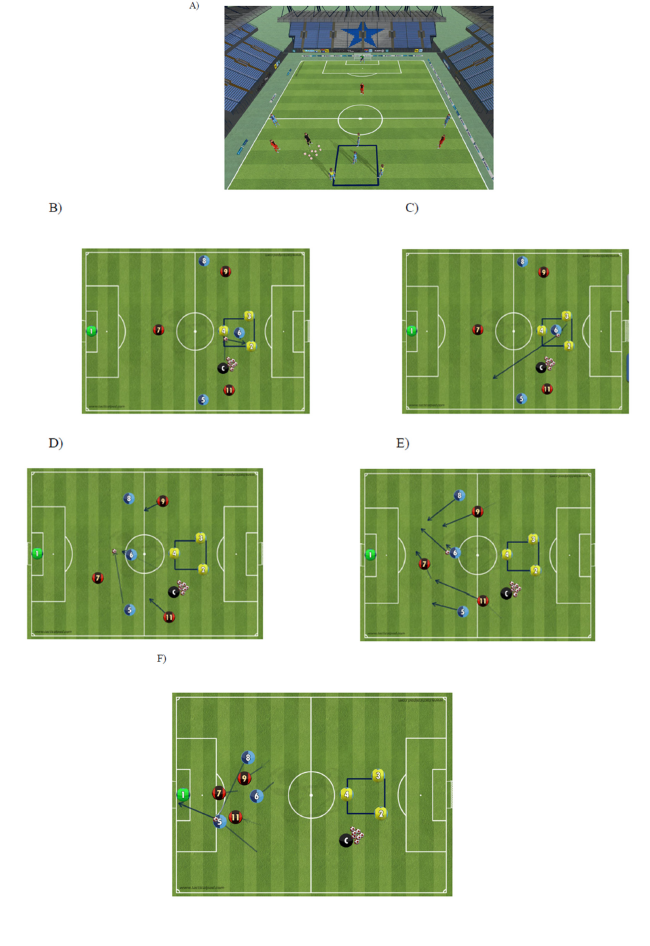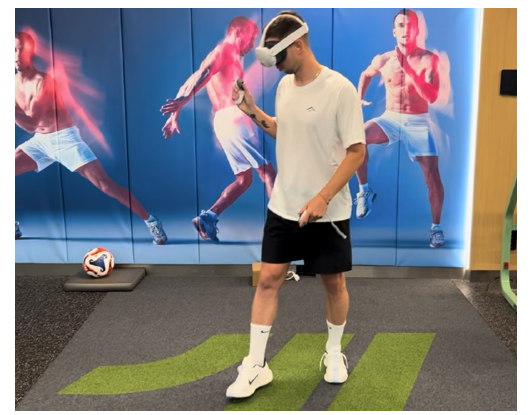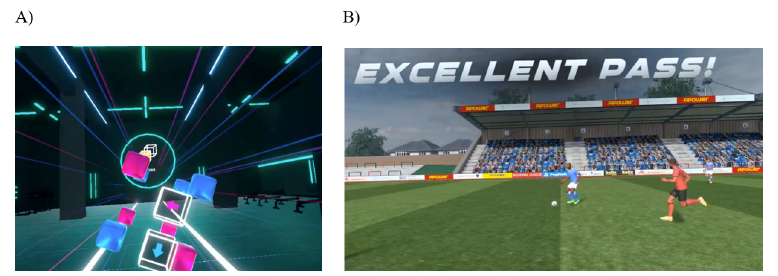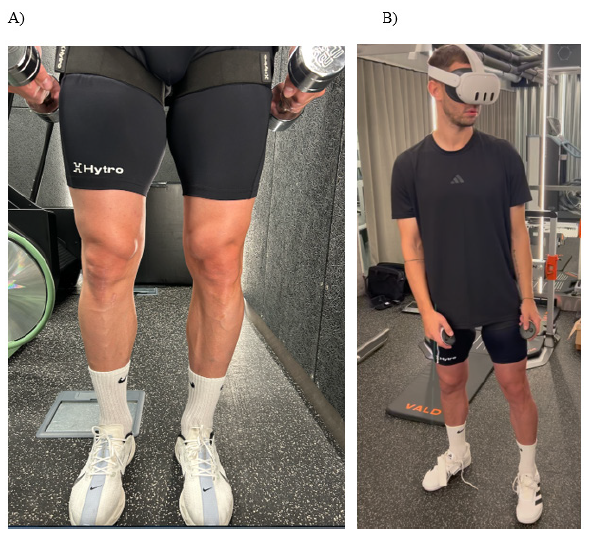- Submissions

Full Text
Research & Investigations in Sports Medicine
Visual-cognitive Skills and Physical Qualities in Elite Soccer: Practical Considerations for Training and Return-to-Play Protocols
Lukasz Bortnik1,3*, David Rhodes2,3 and Jill Alexander3
1Day1 Football Physical Performance, Czech Republic
1Day1 Performance, Medicine & Research, United Kingdom
1Football Performance Hub, Institute of Coaching and Performance (ICaP), School of Sport and Health Sciences, University of Lancashire, United Kingdom
*Corresponding author:Lukasz Bortnik, Football Performance Hub, Institute of Coaching and Performance (ICaP), School of Sport and Health Sciences, University of Lancashire, Preston, United Kingdom
Submission: October 23, 2025;Published: October 31, 2025

ISSN: 2577-1914 Volume11 Issue 3
Abstract
Elite soccer is increasingly demanding, requiring players to cover greater distances at higher speeds while making rapid decisions under high-pressure scenarios. These demands place significant strain on neurophysiological capacities, highlighting the need for integrated training that combines physical, technical-tactical and visual-cognitive development. This is particularly critical for athletes returning from long-term injury, who require both physical rehabilitation and neurocognitive re-adaptation to safely resume competition. Traditional Return-to-Play protocols often overlook compensatory central nervous system adaptations, increasing the risk of movement errors. Contemporary approaches emphasise visual-cognitive skills, supported by divided attention (managing multiple tasks) and selective attention (prioritizing relevant stimuli), while Blood Flow Restriction (BFR) training provides a promising adjunct during rehabilitation, especially when combined with Virtual-Reality (VR) techniques. Integrating these cognitive and physical strategies may enhance performance, reduce movement errors and facilitate safer re-integration into elite soccer.
Keywords: Blood flow restriction; Virtual-cognitive skills; Soccer RTP
Introduction
Elite soccer continues to evolve, with rising physical and technical-tactical demands across many European competitions. As the intensity of the modern game increases, players are expected to cover greater running distances at higher speeds and perform in more dynamic, high-pressure scenarios where decisions made in fractions of a second can determine match outcomes [1]. These evolving demands suggest that players’ neurophysiological capacities are being tested to new limits [2,3]. In practical settings, this underscores the critical need to develop physical and technical-tactical abilities in tandem with visual-cognitive skills. This is especially pertinent for players returning from long-term injury, who must undergo physical rehabilitation and a period of re-adaptation before safely rejoining team training and competitive play [4]. These individuals face an elevated risk of movement errors, often due to compromised motor control under the complex and unpredictable demands of elite competition [4]. For example, evidence indicates that altered brain and spinal cord function (negative neuroplasticity) may persist for years after knee surgery, even following a return to full activity [5]. In addition, persistent biomechanical deficits have been observed long after knee reconstruction, particularly during the penultimate foot contact of the injured limb in change-of-direction tasks [6]. These findings suggest that RTP protocols should place greater emphasis on movement mechanics and sensorimotor control, alongside traditional performance outcomes. Ultimately, a paradigm shift is needed in rehabilitation. The one that integrates elements of “brain training” and cognitive training to more comprehensively address the long-term consequences of injury.
Modern training and preparation must therefore utilize a deep analytical approach and explicitly integrate key visual-cognitive aspects into these processes. Skills such as perception, anticipation and rapid reaction should be considered essential components of contemporary training programs [7]. Both divided and selective attention are vital to stimulate visual-cognitive processes effectively. Divided attention (dual-tasking) refers to the ability to manage multiple tasks simultaneously or switch between them without attentional loss [8]. Selective attention (Table 1) involves identifying relevant and ignoring irrelevant stimuli [9].
Table 1:Definitions, divisions and examples of selective attention in football.

Visual-Cognitive Processes: Practical Applications
Practitioners might ask how visual-cognitive aspects could be applied in practical settings. In real-match scenarios, the concepts of anticipation and reaction can be utilized in various ways to enhance player performance and impose professional development. Table 2 & 3 depict real-world situations that offensive and defensive positions could experience during official matches. In practical settings, embedding visual-cognitive processes in individual and team-based training, including rehabilitation and Return-to-Play (RTP) protocols, is essential for a holistic and safe transition back to full match performance. When injuries limit movement and on-pitch sessions are not possible however, alternative approaches must be considered. A notable example is an Anterior Cruciate Ligament (ACL) injury. It is worth noting that rupture and reconstructive surgery lead to a disruption of sensory input from the knee to the Central Nervous System (CNS), resulting in altered motor behaviours [10]. Consequently, ACL injury should be regarded as a multifaceted musculoskeletal condition, as it encompasses not only mechanical and movement impairments but also cognitive and neurological disruptions. Failing to address these dimensions within rehabilitation, prevention and risk assessment strategies may result in incomplete management and a higher likelihood of recurrent problems [11]. In such cases, a long recovery and multi-staged rehabilitation are required, gradually transitioning from gym-based to pitch-based specific exercises [12] (Figure 1). Rehabilitation, even at early stages, should include tasks that challenge attention, working memory, and visual-spatial processing as shown in Figure 2 & 3. Training plans at more advanced stages must consider the individual’s characteristics and positional demands, where soccer players anticipate, decide and quickly react to constantly changing environments that mimic game-like scenarios [12-15]. For instance, developing the ability to press aggressively, win the ball high and transition instantly into attack has been considered a decisive factor in modern soccer [13]. Figure 1 presents a drill designed to connect defensive pressing behaviors with a quick counter-attack, emphasizing perception, anticipation and reaction in high-tempo game situations. The main aim during this exercise is to condition players for repeated high-intensity efforts in realistic scenarios while enhancing individual and collective awareness in attack and defense [14]. Another practical and progressive approach is the Visual-Cognitive Control-Chaos Continuum (VC-CCC) proposed by Taberner and colleagues [15]. This framework outlines how RTP strategies can progressively integrate various physical and cognitive objectives, which is shown in Table 4. By adopting such structured, cognitively integrated training frameworks, practitioners can maximize the RTP protocols and better prepare athletes for complex, fast-paced scenarios of modern soccer and ultimately enhance their readiness for the match demands.
Table 2:Examples of anticipation scenarios for offensive players in football match-play.

Table 3:Examples of reaction scenarios for defensive players in football match-play.

Figure 1:Specific offensive-defensive drill (3v1 high pressure and counter-attack): a) 3D drill set up; b) 3v1 possession where player nr 6 (blue) applies high pressure to win the ball; c) once possession has been re-gained, counter-attack is initiated; d) 3 blue players counter-attack and 1 red defends (3v1); e) 2 red players are making recovery runs to support defense (3v3); f) blue players quickly enter the box to finish an attack, which must be performed as quickly as possible to use numerical advantage in its early phase. Perform 2 sets of 6-8 actions lasting 20-30 seconds. Use 1:2-3 work-to-rest-ratio. Group activity: 9-15 players. Perception/Anticipation/Reaction. Adopted from Bortnik L [14].

Figure 2:VR goggles used during an ACL rehabilitation.

Figure 3:Virtual reality applications used to improve cognitive skills: A) Inhibition & eye-hand coordination; B) Scanning ability & reaction.

Table 4:Examples of integrated objectives during the Visual-Cognitive Control-Chaos Continuum (VC-CCC).

Blood Flow Restriction and Ischemic Preconditioning
Blood Flow Restriction (BFR), first developed in the 1990s, involves the application of external pressure to partially restrict blood flow during low-load exercise [16]. A growing body of evidence indicates that BFR training promotes muscle hypertrophy, strength, peak power, aerobic capacity, recovery and proprioception [17-21]. In addition to physical outcomes, BFR has been associated with enhanced cognitive performance, such as improved cognitive function in elderly populations [22] and increased cognitive flexibility in young athletes [23]. BFR shorts in particular have been shown to be feasible, practical and safe in applied environments [24] (Figure 4a). Importantly, low-load exercise with BFR elicits adaptations comparable to those achieved with high-intensity training [25]. This makes BFR especially relevant in contexts where high mechanical loads are undesirable, such as Anterior Cruciate Ligament (ACL) rehabilitation or in the days immediately before and after competition in soccer [26]. The primary physiological mechanisms underlying BFR include tissue ischemia, which induces metabolic stress, cellular swelling, anabolic hormone upregulation, and increased expression of neurotrophins such as Brain-Derived Neurotrophic Factor (BDNF) [27]. Together, these mechanisms support both physical and cognitive adaptations while reducing joint stress.
Ischemic Preconditioning (IPC) is a BFR method that involves periods of circulatory ischemia, usually 3 to 4 x 5 minutes, followed by circles of reperfusion of similar or shorter duration in the limbs [28]. This approach elicits high hypoxic stress inducing vasodilation, improving muscle blood flow, enhancing oxygen delivery and ultimately positively affecting various exercise performance [29]. Preconditioning efficacy has been widely reported on strength, power and endurance capabilities [30,31]. From a research perspective however, interests should be directed more towards the IPC effect on sensory-motor patterns and muscular coordination in various athletic populations including soccer players. Evidence suggests that IPC might enhance sensory and proprioceptive feedback during physical activity to correct movements and augment its quality. That might ultimately improve physical performance and reduce potential injury risk, which would be considered of high importance in an athletic population [20,21,26].
Virtual Reality: A Novel Technique in Practical Settings
Virtual Reality (VR) provides a computer-generated threedimensional environment accessed through head-mounted displays and motion controllers, creating an immersive sense of presence in virtual space [32]. VR has been applied in both clinical and sporting contexts to enhance motor and sensory function, cognitive processes and perceptual skills, all of which play a critical role in decision-making in team sports [33]. Research has demonstrated that movement patterns and motor control are largely comparable between physical environments and virtual conditions [34]. Furthermore, VR has proven effective in the evaluation and rehabilitation of gait [35], highlighting its potential as both an assessment and training tool. This technique is particularly valuable when physical loading must be limited, for example during injury rehabilitation or recovery phases in a weekly microcycle in soccer [26]. Although BFR and VR have each demonstrated significant promise, no studies to date have examined their combined use in sport [36]. Conceptually, their integration could provide synergistic benefits, enhancing proprioception, motor and cognitive skills, postural control and physiological adaptations such as muscle size, strength and endurance (Figure 4b). A potential protocol (Figure 5) could involve applying BFR at ~70% limb occlusion pressure (LOP; <200mmHg) bilaterally, as recommended by Neal BS et al. [24], for 3 sets of 5 minutes during VR training, interspersed with 2-minute reperfusion periods [21]. This combined approach may augment both sensorimotor and cognitive outcomes while supporting neuromuscular adaptation. Future research should examine this novel paradigm with particular attention to its relevance for soccer performance, rehabilitation and recovery [37].
Figure 4:New training and RTP methods including: A) Blood Flow Restriction (BFR); B) Combined VR and BFR.

Figure 5:Practical protocol combining blood flow restriction and virtual reality training during rehabilitation and RTP.

Summary and Conclusion
Elite soccer is becoming increasingly demanding, requiring players to produce higher physical outputs while simultaneously making rapid decisions under complex, high-pressure scenarios. These evolving demands place significant strain on neurophysiological capacities, highlighting the need for integrated training approaches that develop physical and technical-tactical skills and visual-cognitive abilities. Such an approach is particularly important for athletes returning from long-term injuries, such as ACL ruptures, where Return-to-Play (RTP) protocols must address both physical rehabilitation and neurocognitive re-adaptation to ensure safe and effective reintegration into competition. Failure to address these cognitive and perceptual components may increase the risk of movement errors and compromise performance.
Emerging technologies provide promising tools to support cognitive development in soccer players. Virtual Reality (VR) offers a low-cost, low-impact method to enhance perception, reaction speed, inhibitory control, eye-hand coordination, scanning ability and visual processing efficiency. VR is particularly advantageous for injured athletes, allowing them to maintain cognitive engagement while minimizing physical stress, thereby facilitating smoother transitions from controlled training environments to on-pitch performance. Additionally, VR-based applications can complement conventional gym- and field-based training routines, providing a powerful adjunct for players at all ages and competitive levels. Furthermore, the integration of VR with Blood Flow Restriction (BFR) training may amplify cognitive and neurophysiological adaptations by combining perceptual-cognitive engagement with physiological stimulation. This synergistic approach may represent potentially a promising tool for rehabilitation and performance enhancement, particularly during periods when high-intensity physical training is not feasible. Systematic research is warranted to explore the efficacy, optimal protocols and long-term benefits of this combined methodology.
From a practical approach, coaches and performance staff could incorporate technology-enhanced cognitive drills alongside traditional physical conditioning, ensuring training scenarios replicate the attacking and defending demands of competition. Exercises should challenge decision-making, attention and perception under realistic constraints, while progression should be tailored to each player’s injury status and readiness. Integrating VR and BFR into structured RTP programs may accelerate cognitivemotor re-integration, enhance tactical awareness and reduce the likelihood of re-injury, ultimately supporting safer and more effective preparation for elite match play.
Key Takeaways
A. Cognitive skills training should focus on perception,
anticipation, decision-making and rapid reaction.
B. Divided and selective attention should be trained in
practical settings.
C. Virtual Reality (VR) provides low-cost, low-impact
cognitive training.
D. VR enhances cognitive skills and could facilitate
smoother transition from controlled environments to on-pitch
performance.
E. BFR can be combined with VR to potentially enhance
neurophysiological and cognitive adaptations in addition to
well-established physiological benefits.
F. Athletes could perform VR-based training while applying
BFR at ~70% of limb occlusion pressure (<200mmHg),
structured as 3 × 5-minute bouts with 2-minute reperfusion
periods.
G. BFR can be useful when high-intensity physical training is
not feasible (e.g., during injury rehabilitation or when fatigued).
Practical Implications
a) Design drills that replicate attacking and defending
scenarios relevant to player positions.
b) Progress training based on injury status, readiness and
competitive demands.
c) Integrate VR + BFR to potentially accelerate cognitivemotor
re-integration and reduce re-injury risk.
References
- Bortnik L, Bruce-Low S, Burger J, Alexander J, Harper D, et al. (2023) Transitional activities in elite football: Frequency, type, effect on match outcome and the novel concept of clusters. RISM 9(5): 872-886.
- Bradley PS (2024) 'Setting the benchmark' part 2: Contextualising the physical demands of teams in the FIFA world cup Qatar 2022. Biol Sport 41(1): 271-278.
- Harper DJ, Sandford GN, Clubb J, Young M, Taberner M, et al. (2021) Elite football of 2030 will not be the same as that of 2020: What has evolved and what needs to evolve? Scand J Med Sci Sports 31(2): 493-494.
- Neto T, Sayer T, Theisen D, Mierau A (2019) Functional brain plasticity associated with ACL injury: A scoping review of current evidence. Neural Plast 2019: 3480512.
- Diekfuss JA, Grooms DR, Hogg JA, Singh H, Slutsky-Ganesh AB, et al. (2021) Targeted application of motor learning theory to leverage youth neuroplasticity for enhanced injury-resistance and exercise performance: Optimal prep. J Sci Sport Exerc 3(4): 17-36.
- Marques JB, Sideris V, Whiteley R, Read PJ, Gomes MM, et al. (2025) Wearable technology identifies differences in change of direction kinetics and kinematics in soccer players with a history of anterior cruciate ligament reconstruction. Knee Surg Sports Traumatol Arthrosc, pp. 1-13.
- Chaput M, Simonm J, Taberner M, Grooms DR (2024) From control to chaos: Visual-cognitive progression during recovery from ACL reconstruction. J Orthop Sports Phys Ther 54(7): 431-439.
- Oberauer K (2019) Working memory and attention-a conceptual analysis and review. J Cogn 2(1): 36.
- Desimone R, Duncan J (1995) Neural mechanisms of selective visual attention. Annu Rev Neurosci 18: 193-222.
- Ward SH, Pearce A, Bennell KL, Pietrosimone B, Bryant AL (2016) Quadriceps cortical adaptations in individuals with an anterior cruciate ligament injury. Knee 23(4): 582-587.
- Soltanabadi S, Minoonejad H, Bayattork M, Seyedahmadi M (2023) Effect of virtual reality and augmented reality training for injury prevention and accelerating rehabilitation of anterior cruciate ligament injury in athletes: A scoping review. Asian J Sports Med 14(4): 1-19.
- Dixon B, Alexander J, Harper D (2025) 'Post-rehabilitation phase' in professional football: Are we optimising player support after return to play? Br J Sports Med 59(9): 625-627.
- Bortnik L, Bruce-Low S, Burger J, Alexander J, Harper D, et al. (2024) Physical match demands across different playing positions during transitional play and high-pressure activities in elite soccer. Biol Sport 41(2): 73-82.
- Bortnik L (2024) Physical demands during contextualised peak intensity periods: Analysis of transitional play, high-pressure activities and 30-second worst-case scenarios in elite football. University of Lancashire, Preston, UK.
- Taberner M, Allen T, O'keefe J, Chaput M, Grooms D, et al. (2025) Evolving the control-chaos continuum: Part 1-translating knowledge to enhance on-pitch rehabilitation. J Orthop Sports Phys Ther 55(2): 78-88.
- Cunniffe B, Sharma V, Cardinale M, Yellon D (2017) Characterization of muscle oxygenation response to vascular occlusion: Implications for remote ischaemic preconditioning and physical Performance. Clin Physiol Funct Imaging 37(6): 785-793.
- Arriel R, Rodrigues J, Souza H, Meireles A, Leitão LF, et al. (2020) Ischemia-reperfusion intervention: From enhancements in exercise performance to accelerated performance recovery-a systematic review and meta-analysis. Int J Environ Res Public Health 17(21): 8161.
- Bennett H, Slattery F (2019) Effects of blood flow restriction training on aerobic capacity and performance: A systematic review. J Strength Cond Res 33(2): 572-583.
- May AK, Russell AP, Gatta PA, Warmington SA (2022) Muscle adaptations to heavy-load and blood flow restriction resistance training methods. Front Physiol 13: 837697.
- Wu J, Zhang P, Zhang Y, Su Y, Shi Y, et al. (2025) Ischemic Preconditioning (IPC) enhances the accuracy and stability of proprioception. Appl Sci 15(14): 7941.
- Patterson SD, Hughes L, Warmington S, Burr J, Scott BR, et al. (2019) Blood flow restriction exercise: Considerations of methodology, application and safety. Front Physiol 10: 533.
- Kargaran A, Abedinpour A, Saadatmehr Z, Yaali R, Amani-Shalamzari S, et al. (2021) Effects of dual-task training with blood flow restriction on cognitive functions, muscle quality and circulatory biomarkers in elderly women. Physiol Behav 239: 113500.
- Liu X, Xiao J, Chen H (2025) Effects of blood flow restriction training on cognitive flexibility in adolescent volleyball players. Percept Mot Skills 132(5): 1149-1168.
- Neal BS, McManus CJ, Bradley WJ, Leaney SF, Murray K, et al. (2023) The feasibility, safety and efficacy of lower limb garment-integrated blood flow restriction training in healthy adults. Phys Ther Sport 60: 9-16.
- Kim D, Singh H, Loenneke JP, Thiebaud RS, Fahs CA, et al. (2016) Comparative effects of vigorous-intensity and low-intensity blood flow restricted cycle training and detraining on muscle mass, strength and aerobic capacity. J Strength Cond Res 30(5): 1453-1461.
- Clarkson MJ, Scott BR, Patterson SD, Damasceno SO, Junior EP, et al. (2022) Virtual reality-based therapy associated with blood flow restriction in older adults: A proposal for integration of techniques. Front Physiol 13: 958823.
- Clarkson MJ, Scott BR, Patterson SD, Warmington SA (2025) Blood flow restriction exercise in high-performance sport settings: A practitioner survey. J Sports Sci 43(19): 2133-2144.
- Schiffer T, Schulte S, Sperlich B, Achtzehn S, Fricke H, et al. (2011) Lactate infusion at rest increases BDNF blood concentration in humans. Neurosci Lett 488(3): 234-237.
- Clarkson MJ, Conway L, Warmington SA (2017) Blood flow restriction walking and physical function in older adults: A randomized control trial. J Sci Med Sport 20(12): 1041-1046.
- Groot PC, Thijssen DH, Sanchez M, Ellenkamp R, Hopman MT (2010) Ischemic preconditioning improves maximal performance in humans. Eur J Appl Physiol 108(1): 141-146.
- Novaes J, Telles LG, Monteiro ER, Araujo G, Vingren JL, et al. (2021) Ischemic preconditioning improves resistance training session performance. J Strength Cond Res 35(11): 2993-2998.
- Patterson SD, Bezodis NE, Glaister M, Pattison JR (2015) The effect of ischemic preconditioning on repeated sprint cycling performance. Med Sci Sports Exerc 47(8): 1652-1658.
- Faure C, Limballe A, Bideau B, Kulpa R (2020) Virtual reality to assess and train team ball sports performance: A scoping review. J Sports Sci 38(2): 192-205.
- Jia Y, Zhou X, Yang J, Fu Q (2024) Animated VR and 360-degree VR to assess and train team sports decision-making: a scoping review. Front Psychol 15: 1410132.
- Gérin-Lajoie M, Ciombor DM, Warren WH, Aaron RK (2010) Using ambulatory virtual environments for the assessment of functional gait impairment: A proof-of-concept study. Gait Posture 31(4): 533-536.
- Gérin-Lajoie M, Richards CL, Fung J, McFadyen JB (2008) Characteristics of personal space during obstacle circumvention in physical and virtual environments. Gait Posture 27(2): 239-247.
- Wu J, Qiu P, Lv S, Chen M, Li Y (2024) The effects of cognitive-motor dual-task training on athletes' cognition and motor performance. Front Psychol 15: 1284787.
© 2025 Lukasz Bortnik. This is an open access article distributed under the terms of the Creative Commons Attribution License , which permits unrestricted use, distribution, and build upon your work non-commercially.
 a Creative Commons Attribution 4.0 International License. Based on a work at www.crimsonpublishers.com.
Best viewed in
a Creative Commons Attribution 4.0 International License. Based on a work at www.crimsonpublishers.com.
Best viewed in 







.jpg)






























 Editorial Board Registrations
Editorial Board Registrations Submit your Article
Submit your Article Refer a Friend
Refer a Friend Advertise With Us
Advertise With Us
.jpg)






.jpg)














.bmp)
.jpg)
.png)
.jpg)










.jpg)






.png)

.png)



.png)






